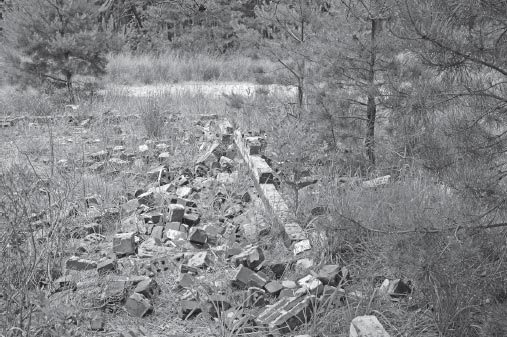
Remnants of the Homeplace cabin, June 2015. Photo by M. Gabriele.
Epilogue
THE FOOTPRINTS OF COLLECTIVE MEMORY
It was an overcast June afternoon when I walked the sugar sand trails of the Waretown-area Pine Barrens with Ed Ahearn as my steadfast guide. Deep in the woods, he led me to an opening where the Homeplace cabin, built by the Albert brothers, once stood. Today, it’s a nondescript vestige—scattered bricks and broken slabs of concrete.
There was nothing haunted about the site; no paranormal occurrences, no supernatural voices echoing in the distance. The only sound was the sweet, dry whisper of the late spring breeze.
The serenity of the Pine Barrens preserves the memories of the Homeplace. It was one stop on New Jersey’s vast musical roadmap. Those who were there years ago for Saturday night jam sessions went on to share music and stories in other places with other friends. And so it continued.
Folklorist Mary Hufford, a senior research scientist with the Appalachian Studies Program at Virginia Polytechnic Institute and State University in Blacksburg, Virginia, in a March 2016 phone interview, defined the concept of collective memory as “recollection reconstituted through shared experience. The means of reconstitution is collective artistic practice.” Hufford said collective memory interacts with a landscape—embracing remembrances “tethered to the recurring seasonal changes of the environment,” like music making at the Homeplace.

Remnants of the Homeplace cabin, June 2015. Photo by M. Gabriele.

Pine Barrens, June 2015. Photo by M. Gabriele.
The Garden State, in all its regional and cultural diversity, has infused its language, imagery, personality and rhythm into songs that make up an important chapter in the folk revival canon. Historian Leonard DeGraaf said that landscape defines what people are capable of doing, as it dictates proximity to creative talent, metropolitan centers and, for the musician, a receptive audience. “History is more than just a sequence of random events,” DeGraaf stated. “People in the past made decisions about their lives and work based on a number of factors. Geography sometimes gets taken out of the analysis of history. Place is important. It’s hard to understand unless you read the landscape.”
New Jersey’s geography as a fertile corridor and crossroads has shaped its musical traditions. Tavern music flourished along colonial stagecoach routes. Celebrated artists were drawn to Camden to make landmark recordings. Bob Dylan traveled to East Orange to find his hero Woody Guthrie and then set off on his legendary career. A gathering of civic-minded individuals in the Morristown area established the Folk Project. Salem County, Stillwater Township, Englishtown and Madison became magnets for bluegrass music. The annual New Jersey Folk Festival on the campus of Rutgers University has entertained and educated thousands of fans. A comprehensive reading of the Garden State’s landscape reveals these milestones and many others, the sum of which forms an interconnected score, an intricate musical saga.
Contemplating the bittersweet passage of time, singer/songwriters create poetry that speaks to the quiet dignity of everyday life. The music becomes a performer’s on-stage “confession” to an audience. Hufford explained that this is part of what Ralph Waldo Emerson described as an “immense intelligence”; a profound, heartfelt truth that possesses us through collective memory. “Music, as one expression of that immense intelligence, accumulated over generations of shared experience in a place, renews the collective experience of belonging to a larger whole that is much older than we are, and also, at the same time, thinking of future generations, much younger,” she said.
The unbridled flow of collective memory carries with it the remnants of salient traditions. Some are sustained, some lost. According to Hufford, tangible artifacts, like the time-worn remains of an old cabin in a pine forest, are only the “footprints” of collective memory—the telltale evidence of a deeper, abiding spirit. She said this spirit endures not only by embracing remembrances but also by moving forward. “It’s through collective artistic forms of communication that the past becomes the head of the trail to the newly imagined future.”
In her 1986 book, One Space, Many Places: Folklife and Land Use in New Jersey’s Pinelands National Reserve, Hufford wrote:
Like [an] aquifer, collective memory must filter itself. People may have stopped making sails and singing shanties, but they still know how to move a garvey [a small fishing boat] through a particular bay. They know how to harmonize within a given musical tradition, whether accompanied by electric or acoustic instruments. The losses of particular aspects of tradition may sadden us in retrospect, but we must not forget that fishermen, boat builders and musicians are still with us and that, in the words of Robert Ames, a menhaden fisherman and shanty singer from Port Norris, the songs are in the fishermen, not in the boats.